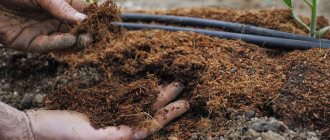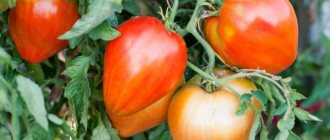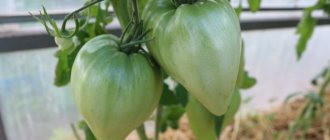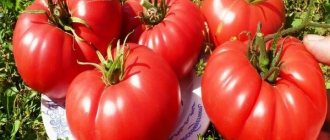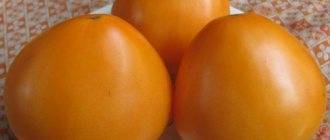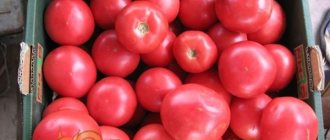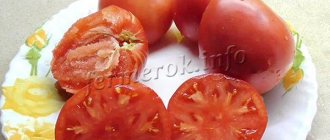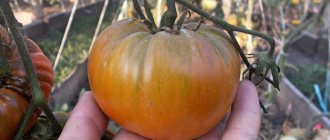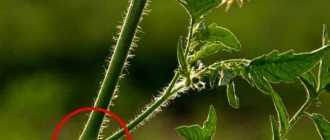Characteristics of the variety
Tall bushes of the determinate type grow to a height of about 1.4-1.8 m. The strong stem of the plants allows them to withstand a fruit weight of more than 500 g. Fruiting of the bushes begins 120-140 days after the appearance of the first shoots.
Most often, the variety is grown in summer cottages or private plots. The variety is not widely used on an industrial scale.
Some varieties of fruit resemble a human heart
A special feature of the Bull Heart variety is the size and shape of the fruit. They are usually pointed at the tip of the fruit and are heart-shaped. Tomatoes can weigh from 100 to 600 g.
The maximum recorded weight is about 1 kg . The largest fruits are formed on the lower part of the bushes. At the top of the stem, smaller tomatoes are 100-150 g. There can be up to 5 fruits in one cluster.
A spreading plant with a small number of leaves is suitable for growing both under cover and in open ground.
History of the variety's creation
This tomato was bred by breeders at the beginning of this century. After the tests, the Bull's Heart tomato was included in the State Register of Russia in 2003 and recommended for cultivation in open ground in the south of the country and in greenhouse conditions in the middle zone, as well as in other regions with similar climatic conditions.
Photo of tomato Bull's heart
Currently, many hybrids of the Bull Heart tomato variety have been bred with similar characteristics, but differing in the color of the fruit - their color can be pink, white, yellow, crimson or black.
Subspecies
The usual color of tomato peel is scarlet (King London, Ox heart pink).
But there are other varieties of the variety with skin:
- yellow (Brown's Yellow Giant)
- red (Bull's heart red)
- orange (Bull's heart orange F1)
- Brad's black heart
- white (White Oxheart)
The most famous varieties are those bred by Russian breeders: “Bull’s Heart Pink”, “Bull’s Heart Orange F1”, “Bull’s Heart Red”.
Brown's Yellow Giant
PROS:
- large-fruited
- high yield
- good gastronomic qualities of fruits
- presence of subspecies.
MINUSES:
- the harvested crop must be used almost immediately
- bushes require constant care
- plants have a late harvest period of about 4 months.
I have been growing "Bull's heart pink" since 1987. I'm satisfied with the yield. The bush is strong and can support up to 9 kg of tomatoes.
Simone
A friend of mine has been planting Bull's Heart tomatoes for several years. Most of all, she appreciates them for their excellent taste and size of the fruit. The first time I tried them was at her place. Now I plan to plant this variety myself on my plot.
Anna
Advantages of the variety
The main advantages of the Bull Heart variety include:
- large fruit;
- excellent taste of ripe fruits of the Bull's Heart tomato;
- good transportability;
- keeping quality up to 2 weeks;
- high yield, especially in greenhouse conditions.
The best varieties of tomatoes:
Tomatoes Royal Temptation F1 Variety Gulliver Spasskaya Tower F1
Among the disadvantages, it is worth noting the low resistance of the variety to late blight and capriciousness when growing.
Productivity
Plants grown under cover produce more fruit. 8-12 kg of tomatoes are harvested from one greenhouse bush. In open ground, the variety can produce 3.5-5 kg of gigantic tomatoes. Their skin is thin.
Easily separated from the pulp. The largest tomatoes form subspecies with dark skin.
Variety "Bull's heart red"
They taste sweet, with a slight sourness. The inside is fleshy, dense, not juicy. They can be eaten fresh, added to salads, or used for canning and preparing various dishes.
Features of agricultural technology
To obtain the maximum number of fruits in the central part of Russia, it is recommended to plant plants in a greenhouse. In most cases, they are planted in open ground only in the southern regions.
Bull's heart orange F1
It is grown by seedlings. The Bull's Heart variety is considered a demanding variety of tomatoes.
We plant the ox heart without any shelter. We follow all the rules of agricultural technology. To avoid fungal diseases, we carry out preventive measures a few weeks after planting. Tomatoes grow big and don’t get sick.
Irina
Preparing seeds for sowing
Seeds are sown in early spring . The seeds of the plant can be prepared independently in the fall, so they retain their varietal qualities. The exception is the varieties - F1 hybrids.
The following activities should be carried out:
- Place the seed material in melt water for 12 hours. You can take clean snow and put it in a warm place, or take ice out of the freezer. Melt water should be at room temperature.
- Disinfect the seeds in a solution of potassium permanganate. Seeds are poured into a slightly pink solution of potassium permanganate and kept for no more than 45 minutes. Then pour the liquid into a strainer. The remaining seeds are washed with clean water.
Brad's black heart tomato
For me, “Bull’s Heart” matures very slowly. By the end of summer, pink specimens only appear. The main part ripens after harvest. I get no more than four tomatoes in my brush.
Sidorenko
Sowing seedlings
Soil from the store is selected from the island. If the soil mixture is prepared independently, it should include:
- leaf soil
- peat
- river sand
- humus
Traditionally, wooden boxes or plastic containers are chosen as containers for planting. Fill the container with soil so that the soil does not reach 3 cm to the edges.
Sowing is carried out in pre-treated, moist, warm soil. Sowing depth – 1-2 cm. Distance between adjacent seeds – 2-3 cm.
Ripe tomato White Oxheart
After planting, the boxes are covered with transparent glass, a bag and placed in a warm place. After the first shoots appear, the shelter is removed. The box is placed in a bright place in the house.
Picking is done after the formation of 2-3 true leaves. At the same time, weak plants are removed and strong ones are transplanted into separate cups or into a more spacious box.
Hardening of seedlings
The process of hardening seedlings
Before transplanting to a permanent place, it is recommended to harden off the grown seedlings. To do this, on warm, sunny days they are taken out to the balcony, loggia or garden. The time spent in the air is increased daily.
Transplanting seedlings
Seedlings are transplanted into the greenhouse at the end of April, beginning of May. The exact timing depends on climatic conditions and the availability of heating in the greenhouse. It is recommended to plant tomatoes in open ground only in the second half of May and early June, when the danger of night frosts has passed.
Bull heart pink
If it is cold or damp outside, it is recommended to postpone transplanting seedlings to a permanent location until weather conditions improve.
Soil preparation
The soil in the area for tomatoes must contain a sufficient amount of nutrients and be air and water permeable. The pH of the soil should be between 6-6.5. You should choose a part of the garden with plenty of sunlight, but without drafts and close groundwater.
Soil preparation
It is recommended to prepare the place for seedlings in the fall by adding organic fertilizers to the ground during digging . If the soil was not enriched with organic matter at the end of the season, in the spring you should add 8-10 kg of compost or humus per m2.
It is also useful to sow green manure plants in the tomato plot in early spring:
- radish
- alfalfa
- mustard
- phacelia, etc.
If nutrients were not added either in the fall or in the spring, mineral fertilizers should be added to each hole during planting. For example, 1 tsp. nitrophoska.
The best predecessors for tomatoes: onions, root vegetables, legumes, cabbage, annual herbs.
Rules for landing in a permanent place
When growing Oxheart tomatoes in a greenhouse, be prepared for the tomatoes to take up most of the cover. This is due to the fact that they are planted in a greenhouse, leaving a distance of 1 m between the beds. The distance between two bushes is at least 40 cm.
Planting depth is 12-15 cm. Planting to a greater depth is possible, but about 4-5 cm should remain between the surface of the earth and the first true leaf. According to experienced vegetable growers, 1/3 of the stem can be buried - up to the cotyledon leaves, but not more.
Planting seedlings in open ground
If the seedlings are planted under cover, the air temperature in it should be 20-22 C during the day and 16-18 C at night. Until the seedlings take root, it is recommended to shade them during the hot sun.
We have many years of experience in growing the variety. In central Russia they do not ripen on bushes. Therefore, either they should initially be planted under cover, or already green tomatoes should be brought home and left to ripen in a warm place. But in a greenhouse they are more likely to suffer from late blight.
Lyudmila
Characteristics and description of the tomato variety Bull's Heart and its varieties
The Bull's Heart tomato variety was included in the State Register of the Russian Federation in 2003. There are no restrictions regarding the growing region. But in terms of ripening, it belongs to late or medium-late. Accordingly, cultivation in open ground is possible only in warm southern regions. When planting in a garden bed in a temperate climate, you simply won’t get a harvest. It takes 120–130 days for the fruits to ripen.
The Bull's Heart tomato is loved by gardeners for its productivity, large fruit and excellent taste of tomatoes.
The bush is weakly leafy, determinate. This property means that its growth is spontaneously limited at the height “set” by the breeders, and a fruit cluster is formed at the site of the growth point. Nevertheless, the bush, unlike the vast majority of determinate tomatoes, is tall, powerful and spreading. In open ground it stretches up to 1.5–1.8 m, in a greenhouse - up to 2 m. The plant will definitely need fairly strong support and regular formation.
Most often, determinate tomatoes are compact, low plants, but the Ox Heart variety is an exception
The first inflorescence forms above the 8–9th leaf. This is quite low, and the tomatoes are large. A trellis or other support is required, otherwise the bushes will bend under the weight of the crop or simply break. And fruits lying on the ground almost inevitably become infected with rot.
Fruits with smooth matte pink-scarlet skin, slightly ribbed. The shape is irregular, they resemble a heart in the anatomical sense of the word - the tomatoes are oval, noticeably flattened. The minimum weight of the fruit is 108–225 g. But the experience of gardeners shows that with proper care, tomatoes ripen much larger, up to 500–800 g. And not individual specimens, but en masse. The largest tomatoes ripen on the lower clusters; the higher they are, the smaller they are. On each bush, 5–7 clusters are formed, almost simultaneously.
The weight of individual fruits of the Ox Heart tomato is approaching a kilogram
Productivity is 3–4 kg per bush when cultivated without shelter and 8–12 kg in greenhouses, but here, too, a lot depends on agricultural technology. If you follow all care recommendations, you can significantly exceed the stated figure.
Oxheart is not a hybrid. Accordingly, seeds from fruits grown by yourself are quite suitable for planting for the next season. But still, planting material periodically needs to be updated. At least once every 4-5 years you need to purchase new seeds, otherwise the tomatoes become noticeably smaller and lose their unique taste.
Not only purchased, but also independently collected tomato seeds Bull's Heart are suitable for planting.
And the taste of the Ox Heart fruit is simply excellent - sweet, with a barely noticeable sourness emphasizing this. The pulp is without whitish streaks, homogeneous, dense, sugary, grainy when cut, reminiscent of a watermelon. The dry matter content is high, so the tomatoes are not juicy. The seed chambers are few (4–5 pieces), the seeds are small.
The pulp of the Bull's Heart tomato is very dense, almost without juice
The Bull's Heart variety cannot boast of having “innate” immunity. Nevertheless, its resistance to fungal diseases typical of the culture is quite good, and it gets sick relatively rarely. The exception is late blight, the prevention of which will require special attention.
The skin of the fruit is quite thin, but they are distinguished by good transportability. When transported over long distances, no more than 5% of tomatoes spoil. Keeping quality is also good. In the refrigerator or other place where a slight positive temperature is constantly maintained, they will last up to 12–15 days without losing their shape, pulp density or taste.
The experience of gardeners shows that the tomato variety Bull's Heart has significantly larger fruits on the lower clusters than on the upper ones.
The large size of tomatoes seriously limits their use. Ox heart is mainly consumed fresh. The variety is not suitable for pickling and pickling because of its sweetish taste and because the fruits simply will not fit into jars. But it is a suitable raw material for preparing tomato paste, ketchup, and sauces.
Ox's heart tomatoes are not suitable for whole-fruit canning, but they make very tasty ketchup
Video: what a Bull's Heart tomato looks like
Many hybrids have been developed based on the Bull's Heart tomato. Most of them were included in the State Register quite recently, in 2017–2018. They, like the “parent”, are suitable for growing throughout Russia, wherever gardening is possible.
- Golden. The bush is indeterminate. The fruits are more regular in shape, round-cone-shaped. Lemon peel. There are many seed chambers, more than six. The average weight of the fruit is 240–280 g. The yield when cultivated in a greenhouse is 13.6 kg/m².
- Compact Early ripening hybrid. The bush is indeterminate. The inflorescence is complex. The fruits are round, pointed at the base, the ribs are almost invisible. The skins are deep scarlet. There are six or more seed chambers. Tomato weight – 160–200 g. Productivity when planted in closed ground – 6–6.7 kg/m².
- Creamy. In terms of ripening, it is classified as mid-season. The bush is indeterminate. Inflorescence of intermediate type. The pulp is less dense than other varieties. The ribs are poorly defined. The skin is an unusual creamy beige color with a slight yellowish tint. The average weight of a flattened tomato is 350–400 g. Productivity is 10.6–12.8 kg/m² when planted in greenhouses. Fruits until the first frost.
- Raspberry. Mid-season hybrid. The bush is indeterminate, densely leafy. The fruits are without ribs, round in shape. Average weight - 350–500 g. The skin is a rich crimson-scarlet color. There are 4–6 seed chambers, the seeds are very small. Up to 6 kg of fruits are harvested from 1 m².
- Orange. According to the ripening period, it is classified as mid-season or mid-late. The bush is indeterminate. The leaves are unusually long. Fruits with pronounced ribbing, the pulp is extremely dense, almost without juice. The skin is a very beautiful saffron shade. The fruits are one-dimensional, weighing 300–350 g. The characteristic taste is somewhat less pronounced than that of other varieties. Productivity in the greenhouse is up to 11 kg/m². Compared to its “relatives” it has better immunity and is more resistant to drought. Regular stepsoning is necessary.
- Peach. Early ripening, the very first of the entire series to ripen. The bush is indeterminate. The inflorescence is complex. The pulp is noticeably watery. The skin is orange-pinkish. The fruits are noticeably ribbed. Average weight - 200-300 g. Productivity - 7.8-8.5 kg/m².
- Pink. Medium ripening hybrid. The bush is densely leafy, determinate, rarely extends above one and a half meters. The fruits are pinkish, slightly ribbed. The pulp is not particularly dense. Tomato weight is 250–350 g. Productivity is 7.5–8 kg/m².
- Black. Early ripening. The bush is indeterminate. Leaves are elongated. The fruits are slightly ribbed, almost one-dimensional (350–400 g). The skin is a very unusual brownish-purple color with a greenish undertone. But to get this shade, you need good lighting. The pulp is very tender, almost without seeds. The yield for the series is almost a record - 12.9–13 kg/m².
- Chocolate. Mid-season hybrid. The bush is indeterminate. The fruits are round in shape, practically without ribs. The skin is reddish-brown. The average weight of a tomato is 240–280 g. The yield is very high – 12.9–13.1 kg/m².
- Amber. Medium ripening hybrid. The bush is indeterminate. The fruits are round, with almost invisible ribs. The skin is dark orange or terracotta. The average weight of a tomato is 350–400 g. 10–12 kg of fruit are harvested from 1 m² in greenhouses.
Photo gallery: hybrids bred from the Bull's Heart tomato
Of all the hybrids in the series, the Bull's Heart Golden variety has the highest yield
The fruits of the hybrid Ox Heart Compact are not very large, this also affects the overall yield
In addition to the unusual color of the skin, Oxheart cream tomatoes are distinguished by the length of the fruiting period
The seeds of the Tomato Bull's Heart Raspberry are so small that they are almost not felt when eaten.
The taste of the Ox Heart Orange tomato is somewhat worse than that of other hybrids, but the variety has better immunity
Tomato Bull's heart peach brings the first harvest of all
The bush of the tomato Bull's Heart is pink, like the “parent”, determinant
The skin of tomatoes, Bull's Heart, acquires the black shade intended by the breeders only if the fruits receive enough sunlight
And the hybrid Bull's heart chocolate, on the contrary, needs partial shade to obtain a characteristic skin tone
Amber ox heart is one of the newest hybrids, gardeners are still practically unfamiliar with it
Care
Plant care is no different from other nightshade varieties and includes:
- watering
- feeding
- loosening
- ventilation of greenhouses
- stepsoning
- mulching
- tying
Watering
The variety is considered drought-resistant. After transplanting to a permanent place, during the rooting of newly planted young plants, there is no need to water them. As soon as the bushes begin to actively grow, watering can be resumed.
On average, for 1 m2 of beds 1-2 times a week you need 5-7 liters of liquid for young plants, 12 liters for adult bushes.
Watering tomatoes over the leaves can cause fungal diseases
On hot days, during the ripening of tomatoes, the maximum amount of water is required - up to 15 l/m2.
For irrigation, you should use warm (20-22 C) settled water . The soil should be moistened early in the morning or evening. Bull's heart tomatoes should be watered only at the root, avoiding water getting on the stem and leaves.
Ventilation of the greenhouse
On warm days, greenhouses need to be ventilated daily. In hot weather, shelter windows should be kept open. Overheating the room can hinder the pollination process.
When growing tomatoes, the greenhouse must be regularly ventilated
The air humidity under the shelter should be 65-70%.
Planted in the Pushkinsky district of the Moscow region. I couldn't ripen them outdoors in open ground. My mother-in-law planted it under cover, and it was ripe before it was removed.
Tigrov
Bush formation
Bull's heart bears fruit well when the bushes form into one stem. The top of the stem is removed when 7-8 clusters with fruits form on the plant.
Stepsoning
"Bull's Heart" is heavily overgrown with stepsons. If you do not remove them in time, this leads to the fact that the bushes devote all their energy to their growth. At the same time, the fruits grow small. Therefore, this variety is not recommended for novice gardeners to plant.
Bull's heart tomatoes need staking
Pinching is the removal of excess shoots on the leaf axils. It is recommended to remove the stepsons when their length has not yet reached 5 cm. Until this moment, there is no risk of injury to the plants. The growth of such shoots must be monitored regularly. Usually the need to remove new stepsons arises every week.
Top dressing
During the growing season, tomatoes are fed 3-4 times. If signs of deficiency of any elements are noticed, the number of procedures can be increased. But nutrient mixtures are applied no more than once every 2 weeks, alternating root and foliar feeding.
Fertilizing
It is recommended to use organic matter as fertilizer. For example, chicken manure, diluted with water in a ratio of 1:15, cow manure - 1:10. Minerals can only be applied 2 months before harvest.
Recipes for preparing natural fertilizers for tomatoes
No. 1. Iodine Place 4 drops of iodine in a bucket of water. Water 2 liters for each plant. The product is not only a fertilizer, but also helps the bushes resist late blight.
No. 2. Ash Add 100 g of ash to a bucket of water. Water under each bush.
No. 3. Herbal infusion Add 5 buckets of water to 5 kg of cut grass. Add some ash and mullein. Keep for several days. Water is added to the liquid so that the final volume is 100 liters. To water 1 bush you need 2 liters of mixture.
No. 4. Yeast 11 g of dry yeast are diluted in warm water. Add 2 tbsp. Sahara. The resulting mixture is poured into a bucket of water. Each tomato is watered at the root with 500 ml of liquid.
Feeding tomatoes with natural fertilizers allows you to get an environmentally friendly product
Tying up
Plants with long stems can be tied up immediately after planting to a permanent place of growth. To do this, usually take a peg about 2 m long and bury it in the ground next to the bush.
Then the stem is tied to this peg. To prevent the top of the plant from drooping and breaking under the weight of the fruit, the location of tying is changed as it grows.
The long stems of the plant do not allow it to be grown without tying it up
You need to make sure that the tomatoes do not come into contact with the ground, as in this case they begin to darken and rot.
Mulching
The ground can be mulched with sawdust, peat, straw, etc.
To facilitate the process of caring for bushes, the ground under them can be covered with a 5 cm layer of mulch.
It performs the following functions:
- holds water in the soil
- eliminates the possibility of weed growth
- protects tomatoes in contact with the ground from rotting
Pollination
Tomatoes growing outdoors can easily be pollinated by insects and wind. There is no free air circulation in the greenhouse, so it is recommended for such plants to help in this process.
Greenhouse tomatoes sometimes need help with pollination
During flowering, some gardeners recommend simply tapping the pegs to which the plants are tied. This should be done in the morning or in the evening.
Planting seedlings and preparing for it
The Bull's Heart tomato variety is quite capricious. This also applies to the requirements for cultivation conditions. An open place is selected for the garden bed. The culture does not tolerate dense shade, but it does not like direct sunlight either. Therefore, it is advisable to grow these tomatoes under a canopy made of any white covering material.
Bull's heart tomatoes are planted so that each bush is provided with sufficient area for nutrition
Areas where groundwater is located a meter or closer below the surface of the earth are immediately excluded. If there is absolutely no alternative, you will have to build high beds (0.5 m or more).
The bushes of this variety are quite large and the root system is developed. Therefore, per 1 m² no more than two plants are placed in a greenhouse and three in open ground. The interval between neighboring bushes is about 1 m, the row spacing is 70–90 cm. You also need to provide space for a trellis or other support.
Obtaining a bountiful harvest is impossible in a substrate of poor quality. The soil must be highly nutritious, but at the same time quite light, allowing for normal aeration and not allowing moisture to stagnate at the roots. The most suitable substrate is gray soil or loam. If its composition is far from optimal, add sand (for heavy soil) or powder clay (for light soil).
The quality of the substrate is also affected by the crop previously grown in this place. Ox's heart is never planted after other tomatoes or any Solanaceae in general, if less than three years have passed. Good predecessors for the crop are green manure, herbs, onions, garlic, plants from the Pumpkin, Legume and Cruciferous families. And the Bull's Heart also benefits greatly from the proximity to garden strawberries. In both crops, the fruits ripen larger, and accordingly, the yield increases.
Eggplants, like other plants from the Solanaceae family, are undesirable precursors for tomatoes
You need to take care of preparing the beds in advance, last fall. Immediately determine the acid-base balance of the soil. If it differs from neutral, during the digging process, dolomite flour, wood ash or eggshell powder (250–450 g) are added along with the necessary fertilizers. To increase fertility, manure (necessarily rotted) or compost is distributed over the bed, approximately 10 liters per linear meter. In the fall, potassium and phosphorus fertilizers are needed - 25–30 g and 40–50 g, respectively. Nitrogen (10–15 g) is applied in the spring, simultaneously with loosening the beds, which is carried out approximately two weeks before planting the Ox Heart.
Humus is a natural remedy for increasing soil fertility
Video: preparing soil for tomatoes
The greenhouse for tomatoes is also prepared in the fall. If possible, it is advisable to completely change the soil. Or at least add 8–10 cm of fresh humus. The soil is dug up, simultaneously getting rid of all plant debris, and spilled with boiling water or a rich raspberry solution of potassium permanganate for disinfection. Glass and all surfaces in general are wiped with a solution of slaked lime for the same purpose. Or you can burn a small piece of sulfur with tightly closed doors and windows.
Ideally, before planting tomatoes in a greenhouse, you need to replace all the soil; if this is not possible, the substrate should at least be disinfected
To enrich the soil with nitrogen and improve its quality in the greenhouse at the beginning of autumn, you can plant any green manure (leaf mustard, vetch, phacelia). After about two months, the greens are mowed and embedded in the soil.
It is advisable to plant tomatoes in cloudy, not too hot weather. The soil should have warmed up sufficiently by this time. It is enough if during the previous week the daytime temperature does not fall below 17°C.
First, both the seedlings and the holes are well shed with warm water. A handful of humus and a little ash are placed at the bottom. The seedlings are planted so that at least 3–4 cm remains from the ground to the bottom pair of leaves. The bushes are well watered again, and it is advisable to mulch the bed. The next watering is carried out only when the seedlings have taken root in the new place and begin to grow. This usually takes about 10 days. Around this time they will need to be tied to a support. After another 1.5 weeks, it is advisable to hill up the bushes to stimulate the development of adventitious roots. Tomatoes in open ground are protected from direct sunlight for at least the first two weeks using covering material on the arches.
Planting tomato seedlings in the ground is practically no different from a similar procedure for other garden crops.
Video: planting tomato seedlings in a garden bed
Diseases and pests
The variety is considered not resistant to late blight . If the weather is cool and the soil is waterlogged, the disease may affect Bull's Heart.
Therefore, it is necessary to observe preventive measures:
- disinfect seeds, soil, containers, greenhouse premises before planting
- leave the required distance between bushes
- do not plant seedlings in a permanent place where other nightshades (peppers, potatoes, etc.) used to grow.
- ventilate the greenhouse
- monitor the moisture level in the soil
Some vegetable growers treat bushes twice a season with antifungal drugs for preventative purposes. Bushes with obvious signs of disease are dug up by the roots and burned.
In addition to late blight, “Bull's Heart” can become infected with fusarium, cladosporiosis, and verticillium . But unlike late blight, the variety has average resistance to these diseases.
Tomatoes are most often affected by late blight.
When growing tomatoes, I use antifungal drugs in accordance with the instructions. The plantings did not suffer from late blight. I noticed for myself that “Bull’s Heart” bears fruit better in a greenhouse than without shelter.
Faith
Growing in a greenhouse
Many summer residents prefer to grow tomatoes of this variety in greenhouses and greenhouses. Especially residents of the northern and northwestern regions of the country.
If the greenhouses are not heated, then tomatoes are grown towards the end of spring. In heated ones, work on planting tomatoes begins already in April.
Bull's heart in a greenhouse
Greenhouses must be well ventilated. Do not allow drops of moisture to appear on its walls.
When the bush reaches 25 cm in height, it needs to be planted in a permanent growing location. Afterwards, be sure to tie it up, otherwise it will simply break under the weight of the branches and fruits. In the future, the ovaries are also tied, taking into account the weight of the fruit.
Bushes need to be formed correctly. Only a couple of stems are left on the bush, the rest are removed. All lower foliage is completely torn off to the lower raceme with the ovary. To achieve a good harvest, you need to leave no more than 8 clusters with ovaries.
Harvesting
Tomatoes are harvested as soon as they are ripe. Usually the first harvest can be enjoyed in July, August and until September.
It is not worth waiting for all the tomatoes on one bush to ripen, as ripe fruits quickly deteriorate.
The collection of all fruits must be completed before the night air temperature drops below 8 C. During collection, all tomatoes must be dry.
Bull's heart tomatoes do not always ripen fully on the plant
“Bull's heart” is a variety of nightshade, the fruits of which are not suitable for long-term storage. Ripe, picked tomatoes can be stored for about 2 weeks. Then the taste deteriorates, but they remain suitable for heat treatment. The transportability of the fruit is excellent.
You can choose a refrigerator or another dark, cool place in the house to store the harvested crop. The room temperature should be 5-12 C. It is recommended to place tomatoes with the stem facing up.
Reviews
Vitaly Servol, Kursk : I grew this variety for several seasons, but decided to give it up. The tomato is tasty, large, there are no complaints here. I didn’t like that the plant dropped its flowers a lot. As a result, the harvest is small; I have never reached the promised 3 kg. I'm thinking of trying hybrids, maybe I'll have better luck with them.
Marina, Balakovo : Despite the fact that new interesting varieties are appearing, I don’t refuse Bull’s Heart. I really like this tomato - the cut flesh is sugary, there are few seeds, the weight is decent. The inflorescences of the plants are powerful; not once did the flowers fly around en masse. On the contrary, she tore off the extra ones herself, leaving 3 pieces in the brush, no more. The only disappointment was the quality of the purchased seeds - not all corresponded to the variety. I will continue to grow from my own.
Maria Aleksandrovna, Ufa : I fell in love with the variety for a long time, every year I plant several bushes. To get a harvest, I always form a plant into 1 stem, regulate the number of clusters (no more than 7-8) and leave only 2-3 fruits in each. At the beginning of August, I pinch the top and tear off the flowering clusters. They are no longer useful, and they take away the bush’s strength.
Application
The size of Ox's Heart tomatoes does not make it possible to preserve them whole. They are usually used to prepare borscht dressings, lecho, salads, and ketchup. Low-juice fruits should not be used to make tomato juice.
Ox heart tomatoes can be used for canning in slices
Sweet tomatoes are great for fresh consumption. They can also be added to various hot dishes or frozen.
Preparing seeds for planting next season
Seeds from fruits that were grown in your own garden can be sown for no more than 4 years. In the future, they may lose varietal qualities.
Procurement of seeds
Experienced gardeners recommend preparing seeds as follows:
- select the largest tomato from the second brush from the bottom
- wait for it to fully mature
- pick the fruit and keep it in the house for several days
- cut the tomato, remove the seeds
- dry them
- put the seeds in paper envelopes
